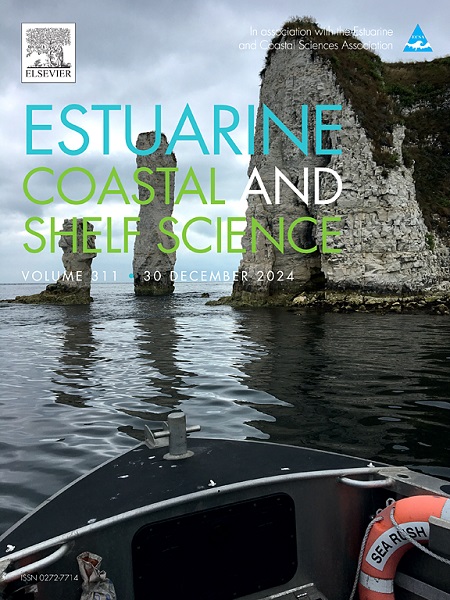Eukaryote biodiversity in supratidal microbialite pools: A foundational environmental DNA assessment
IF 2.6
3区 地球科学
Q1 MARINE & FRESHWATER BIOLOGY
引用次数: 0
Abstract
Coastlines are a mosaic of habitats, including rocky shores, sandy beaches, estuaries, and artificial substrata. Although modern microbialite pool formations were only recently discovered as an additional coastal habitat along the southern African coastline, they are now known to be surprisingly common to this region. These ecosystems function similarly to estuaries, where seawater and freshwater mix, but with groundwater as the freshwater source instead of river flow. Traditional community assessments from morphological identifications have revealed some similarities between the organisms inhabiting microbialite pools to those of nearby estuaries, but no systematic comparison has so far been undertaken. Here, we used molecular methods based on environmental DNA (eDNA) metabarcoding to characterise the eukaryote assemblages within and between three coastal southern African microbialite pools. We hypothesised that the three sites are taxonomically analogous to one another, which would support the existence of similar core ecological communities. Three genetic markers, one for metazoans (COI) and two for algae (rbcL and the V2+V3 regions of 18S rRNA) were targeted for metabarcoding. Our results show that the biodiversity of the pools was dominated by diatoms (particularly of the genera Navicula and Nitzschia) and, among the metazoans, by malacostracans, rotifers and nematodes. Although the three microbialite pools had similar broadscale community compositions at higher taxonomic levels (class and family), distinct community structure at lower taxonomic levels was observed, which may be a result of numerous opportunistic species being present in addition to the core organisms. The macroinvertebrate fauna of microbialite pools (e.g. peracarid crustaceans, polychaetes and insects) is well documented, although most are still missing from the DNA barcoding reference library. In contrast, the meiofauna (e.g. rotifers, nematodes and ostracods) is understudied. It remains unclear whether the two dominant diatom genera are the primary contributors to microbialite formation, or if other yet-undescribed species also contribute to the process. This study serves as an initial step in uncovering the hidden level of biodiversity within the unique microbialite ecosystems along the southern African coastline.
潮上微生物池中的真核生物多样性:基础环境DNA评估
海岸线是栖息地的马赛克,包括岩石海岸、沙滩、河口和人工基质。虽然现代微生物岩池地层是最近才发现的,是非洲南部海岸线上的一个额外的沿海栖息地,但现在人们知道它们在这个地区非常普遍。这些生态系统的功能类似于河口,海水和淡水混合在一起,但淡水来源是地下水,而不是河水。形态学鉴定的传统群落评估揭示了栖息在微生物岩池中的生物与附近河口的生物之间的一些相似性,但迄今为止尚未进行系统的比较。在这里,我们使用基于环境DNA (eDNA)元条形码的分子方法来表征三个沿海南部非洲微生物池内部和之间的真核生物组合。我们假设这三个地点在分类上彼此相似,这将支持相似核心生态群落的存在。三个遗传标记,一个用于后生动物(COI),两个用于藻类(rbcL和18S rRNA的V2+V3区域)进行元条形码编码。结果表明:水塘生物多样性以硅藻属为主,其中以硅藻属和硅藻属居多,后生动物以甲壳类、轮虫类和线虫为主。虽然在较高的分类水平(纲和科)上,3个微生物岩池具有相似的大尺度群落组成,但在较低的分类水平上观察到不同的群落结构,这可能是由于除了核心生物之外还有许多机会性物种存在的结果。微生物岩池的大型无脊椎动物区系(如过硬壳类动物、多毛类动物和昆虫)已被很好地记录下来,尽管大多数仍未从DNA条形码参考库中找到。相比之下,小型动物(如轮虫、线虫和介形虫)的研究不足。目前尚不清楚这两种主要硅藻属是否是微生物藻形成的主要贡献者,或者其他尚未描述的物种是否也有助于这一过程。这项研究是揭开非洲南部海岸线独特的微生物生态系统中隐藏的生物多样性水平的第一步。
本文章由计算机程序翻译,如有差异,请以英文原文为准。
求助全文
约1分钟内获得全文
求助全文
来源期刊
CiteScore
5.60
自引率
7.10%
发文量
374
审稿时长
9 months
期刊介绍:
Estuarine, Coastal and Shelf Science is an international multidisciplinary journal devoted to the analysis of saline water phenomena ranging from the outer edge of the continental shelf to the upper limits of the tidal zone. The journal provides a unique forum, unifying the multidisciplinary approaches to the study of the oceanography of estuaries, coastal zones, and continental shelf seas. It features original research papers, review papers and short communications treating such disciplines as zoology, botany, geology, sedimentology, physical oceanography.

 求助内容:
求助内容: 应助结果提醒方式:
应助结果提醒方式:


